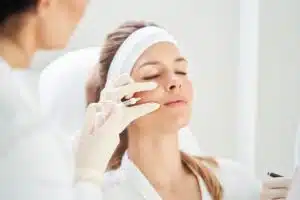Achieving radiant and healthy skin is a year-round commitment, and understanding the core principles of a sustainable skincare routine can make the journey smoother and more effective. Seasonal changes may influence your skin’s needs, but by mastering a foundational routine, you can ensure your skin remains vibrant and well-nourished throughout the year.
In this blog post, we’ll guide you through the essential steps of a comprehensive skincare regimen for various skin types. Join us at BCI Clinic as we help you craft a personalized skincare journey tailored to your unique needs, ensuring your skin stays glowing and healthy all year long.
Sensitive and Redness-Prone Skin
Sensitive and redness-prone skin is characterized by diffuse redness, visible blood vessels, and highly reactive or irritated skin. It’s most common in women aged 30 to 50 with fair pigmentation, primarily affecting the cheeks, nose, chin, and forehead, but it can also be present in men of the same demographic. The exact cause is unknown, and it can’t be completely cured, but with a good skin care regimen, it can be managed.
Skincare Routine
- Cleanse. Use a gentle cleanser to help balance your pH and remove excess oils.
- Serums. We recommend two serums to keep redness at bay:
- An antioxidant serum with vitamins E and C as well as L-ascorbic acid to keep your skin fresh.
- A soothing serum with piperonyl glucose to keep your skin hydrated.
- Moisturize. Choose a soothing, gentle moisturizer with antioxidants and calming ingredients like hyaluronic acid and aloe.
- SPF. As sun exposure can cause redness, choosing a good SPF is crucial. Look for a lightweight physical sunscreen that can create a barrier between your skin and the UV rays.
Aging Skin
Your skin changes as you age. The barrier of the outer layer (the epidermis) is reduced, causing transepidermal water loss (TEWL), where water from the inner layer (the dermis) passes through the epidermis and evaporates, causing dehydrated and sensitive skin. Cell turnover also slows down as you age, causing uneven texture and changes in pigmentation, and collagen depletion causes wrinkles.
There are two main types of aging. The first is intrinsic, or chronological, aging, which cannot be controlled as it’s simply a natural process of time on your skin. The second is extrinsic aging, which is aging due to external factors like stress, sun exposure, pollution, and lifestyle factors. This can be controlled and even reversed with a skincare routine or aesthetic treatments.
Skincare Routine
- Cleanse. Choose a hydrating pH-balanced cream cleanser to clean your skin.
- Serums. We recommend three serums for aging skin:
- An antioxidant serum with L-ascorbic acid and vitamins E and C.
- A peptide serum with hydrating and anti-aging ingredients like sodium hyaluronate.
- A retinol serum to improve skin texture.
- Moisturize. Choose a hydrating moisturizer with peptides, antioxidants, and other soothing ingredients.
- SPF. Using a physical, broad-spectrum facial sunscreen will keep UV rays off and keep your skin looking young.
Blemish-Prone Skin
Blemishes most often appear on the face but can also occur on the neck, shoulders, chest, and back. They can be caused by excess oil or sebum production, dead skin cells and debris, or the C. acnes bacteria. Regardless of the cause, there are two main types of blemish-prone skin.
The first is non-inflammatory acne, characterized by blackheads and whiteheads. These occur when a plug of sebum builds up around a hair follicle, and the main difference is whether there is a thin skin covering over the plug. Blackheads are not covered and end up oxidizing, causing a darker colour.
The other is inflammatory acne, which occurs when the sebum or dead cells blocking the follicle begin to press on the follicular wall and create pressure and redness. These can be papules, which are pink or red bumps with a white or yellow center. It can also cause pustules, which are red with a white or yellow center and draw on white blood cells to fight the infection. Finally, inflammatory acne may also cause cysts or nodules, which are larger painful lesions that go deeper into the skin.
Skincare Routine
- Cleanse. We recommend using a clarifying cleanser with salicylic acid, which will target oil build-up.
- Serums. There are two serums we recommend to help blemish-prone skin.
- A retinol serum to enhance cell turnover.
- An acne-balancing serum with reservatol and salicylic acid, which can reduce the onset of breakouts.
- Moisturize. Choose an anti-oxidant-rich moisturizer that’s formulated for oily and acne-prone skin to help hydrate and let it breathe.
- SPF. Using a lightweight, physical sunscreen can help protect your skin from sun damage, which can exacerbate skin conditions.
Crafting Your Personalized Skincare Journey
Everyone’s skin is unique, so your skincare regime will likely look different from everyone else’s, and that’s okay! The best skincare routine is the one you’ll stick to because consistency produces the best results—if that means you have to remove a step or combine products, such as using a moisturizer with SPF, trust the process! If you need a beauty boost in addition to your at-home regime, BCI Clinic is here to help.
Our expert team aims to enhance your natural beauty, target areas of concern, and leave you feeling more confident. Contact us today to book a consultation and learn more about our skincare treatments. Together, we can ensure your skin glows all year long.




